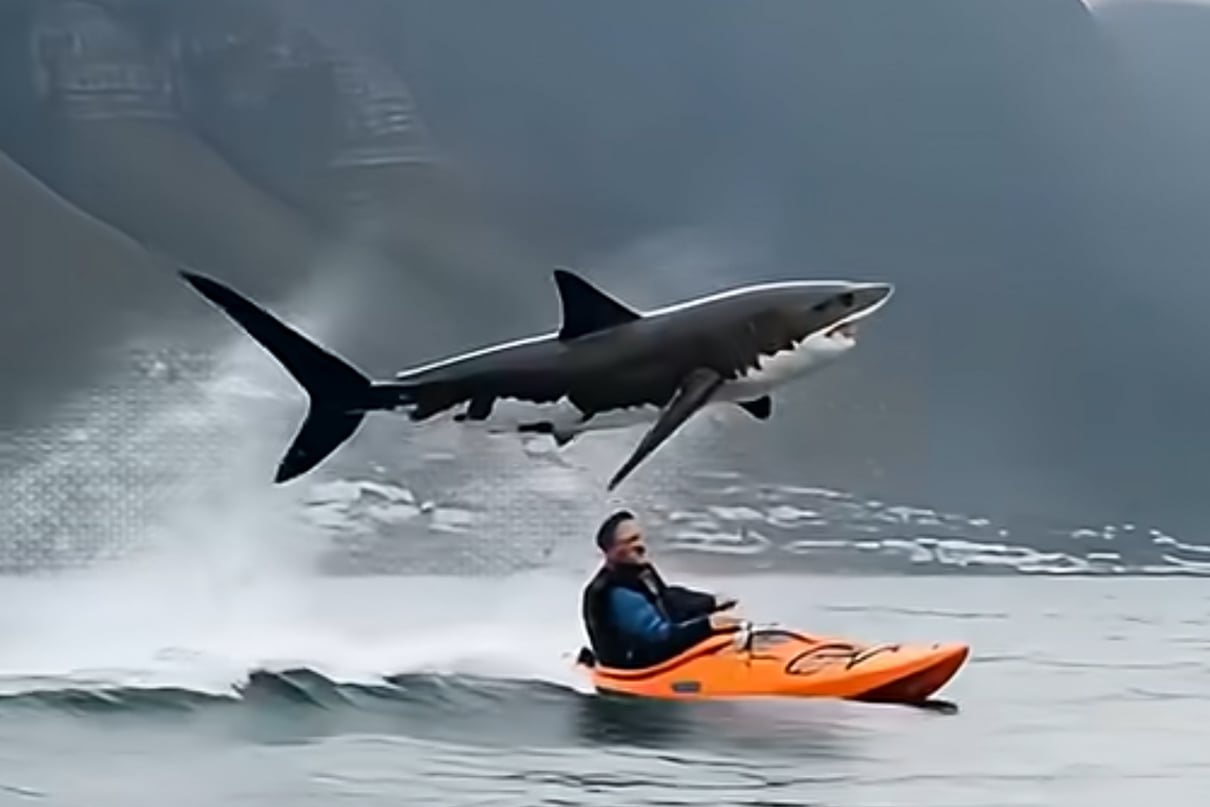There are plenty of very real and very frightening shark and kayaker encounters caught on film, but these recent viral videos aren’t among them. From improbable encounters to paddles that go straight through the rotomolded deck of a kayak, here are the most ridiculous artificial intelligence (AI) generated shark attack on kayaker videos on the internet:
Shark heavy breaths on kayak
In this viral YouTube short, a massive shark emerges from the ocean to heavy breathe on the bow of a recreational kayak – never mind, of course, that sharks do not breathe air. While the video is distinguishable as AI-generated from the unnatural shine on the shark’s back and the grid-like noise in the image that appears in the ripples and splashes, the video is perhaps most obviously a fake based on the behavior of the shark itself.
While many commenters observed that the video is obviously AI-generated, with one commenter noting that the 1975 film JAWS had more realistic shark footage than the viral video, other viewers were not convinced that the footage was fake.
Shark lands on handless kayaker
While this YouTube short is slightly more difficult to discern as AI-generated initially, the warping tangle of shark landing on a kayaker makes it pretty clear something with reality is amiss. The kayaker appears to be surfing a small wave without a paddle when a shark breaches and soars through the air behind him. The shark appears to land on the kayak – that’s when things get a little fuzzy.
The kayaker appears to be at least partially ejected from the kayak and tumbled at least twice before appearing upright in his kayak at the end of the video, making for the most impressive renter and hand roll of all time – that is, if the paddler had hands of course, which he does not. To the video’s credit, the handless kayaker does appear to be wearing a PFD.

Beyond the improbability of the shark encounter and extremely unlikely behavior of the kayaker, the video also shows the grid-like noise in the water most apparent when the video is paused, a telltale sign of AI-generated video.
While by the end of the YouTube short the AI qualities of the video may seem obvious, several commenters weren’t so sure, sharing that it took several watches to discern whether or not the video was fake.
Great white shark gently nibbles on kayak
In this utterly ridiculous YouTube short, we see an improbably buoyant shark gnaw on the bow of a sit-on-top kayak before flinging some water at the screen. The video is accompanied by the grunts and gasps of what viewers can only assume is meant to be the AI-generated kayaker, and not the shark.
The movements of the video are far from the fluid movements of footage shot on a camera, and the kayaker’s paddle appears to go clean through the deck of the plastic kayak as the video moves.
While sharks do rarely attack kayaks, this video isn’t a real recording of such an encounter.
How to tell if a video is AI-generated:
The biggest tell for AI-generated footage is often the content itself – all of the videos above depict extremely unlikely shark behavior or, in some cases, unlikely kayaker behavior such as the absence of an actual paddle in the second video. Beyond situation and surface-level visual cues, there are other ways to determine if a video is genuine footage or generated by AI.
If you suspect a video may be AI-generated but aren’t sure, visit the profile of the page that posted the video. Are all of the images and videos on the page incredible kayak encounters with sharks or equally unlikely scenarios? Repeated fantastical videos could be a sign that the page posts AI-generated content.
Another way to pick out AI-generated content is to pause the video and look closely at the details and edges of elements within the image. For example, you might notice a warped kayak deck in a video where shark teeth meet a kayak, or you might notice that a kayaker has no hands in certain frames. Additionally, the grid-like noise in moving water is a telltale sign of AI-generated video.
Overall, trust your instinct. Whether the contrast of the colors is a little too pronounced, or the motion is just not quite true to reality, your gut feeling about a potentially AI-generated video could be telling you something. Not unlike the uncanny valley phenomenon, which refers to the increasing discomfort humans report when viewing faces that are not quite human, the unease you may feel while viewing a video you believe to be AI-generated may be a sign that it isn’t real.
Currently with a little practice it’s fairly easy to distinguish between AI-generated videos and videos shot in the real world on a camera, but as AI technology improves we can expect telling the real from the artificial to become more difficult.
An AI-generated shark comes in for a nibble. Featured Image: APEXOCEANSIM | YouTube








The thought of being eaten by a fish, that sucks!